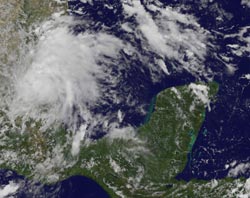Satellite Sees Atlantic Tropical Depression Eight Form in Southwestern Gulf of Mexico

NOAA's GOES-East satellite captured the birth of Tropical Depression Eight in the southwestern Gulf of Mexico at 2:31 p.m. EDT on Sept. 6. <br>Image Credit: NASA GOES Project <br>
NOAA's GOES-East satellite image showed a large circulation associated with Tropical Depression 8 or TD8 after it was officially designated a depression by the National Hurricane Center. The image was created by NASA's GOES Project at the NASA Goddard Space Flight Center in Greenbelt, Md.
The center of TD8 formed right along the eastern coast of Mexico near Tampico and was making landfall after it formed. At 2:30 p.m. EDT, the center of the depression was directly over Tampico. It had maximum sustained winds near 35 mph/55 kph and was moving to the west-southwest at 6 mph/9 kph.
Minimum central pressure is 1009 millibars. Despite making landfall quickly, there are no watches and warnings in effect, although it is expected to drop rainfall between 3 and 5 inches in the Mexican states of Veracruz and Tamaulipas. Some areas may receive isolated maximum amounts up to 10 inches, and could experience flash-flooding and mudslides.
According to the National Hurricane Center, TD8 is going to be short-lived because it is moving over land. In fact, the NHC expects the depression to become a remnant low pressure area over the weekend of Sept. 7 and 8 as it drops more rainfall on its track to the west-southwest.
Text credit: Rob Gutro
NASA's Goddard Space Flight Center
Media Contact
All latest news from the category: Earth Sciences
Earth Sciences (also referred to as Geosciences), which deals with basic issues surrounding our planet, plays a vital role in the area of energy and raw materials supply.
Earth Sciences comprises subjects such as geology, geography, geological informatics, paleontology, mineralogy, petrography, crystallography, geophysics, geodesy, glaciology, cartography, photogrammetry, meteorology and seismology, early-warning systems, earthquake research and polar research.
Newest articles

Properties of new materials for microchips
… can now be measured well. Reseachers of Delft University of Technology demonstrated measuring performance properties of ultrathin silicon membranes. Making ever smaller and more powerful chips requires new ultrathin…

Floating solar’s potential
… to support sustainable development by addressing climate, water, and energy goals holistically. A new study published this week in Nature Energy raises the potential for floating solar photovoltaics (FPV)…

Skyrmions move at record speeds
… a step towards the computing of the future. An international research team led by scientists from the CNRS1 has discovered that the magnetic nanobubbles2 known as skyrmions can be…




















